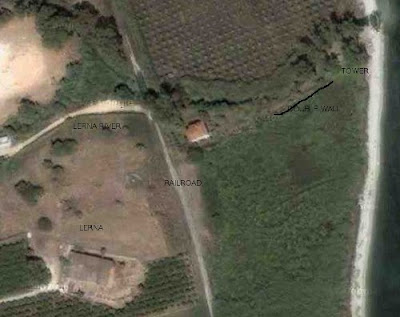Detail, Klontzas, Passion
The earliest documentary evidence for Krokodylos Kladas seems to be a letter from Jacopo Barbarigo of 25 July 1465. It is true that Sphrantzes wrote about him in terms of 1460, but Sphrantzes was writing after 1472 when he became a monk.
Barbarigo was provveditor general of the Italian troops in the Morea for a year of the Ottoman-Venetian war. Eighty-seven of his letters survive, written betwen 5 June 1465 and mid-March 1466, and they can be found starting on page 1 of volume 6 of Sathas here.
Twice Barbarigo gives distinct lists of the men who he says are the leading men of the Morea – homini da conto, zentilhomini, i molti principali, le persone de i condition. Combining the two lists, in their spelling, we get:
Petro Bua
Alexio Bua
Gini Bua Protostrator, Isaac Paraspondylos
Michali Rallis “principal homo de questa Amorea”
Michali Rallis Drimi dal Granzas [Graitzes]
Peregrino Busichi & his brother
Matheo Sfranzi [Sphrantzes]
Epiphani & Corcondilo Clada
A few other names can be collected from various Barbarigo letters:
Comes Glava
Comes Comnino
Comes Megara
Nikolaos Boccali and brother
Manoli Clada
5 Manessi kapetanioi
Silas and Zorzi Busichi, principali de Busichi
Ioannis Menaia
The three counts are not from the Morea, Komninos and Glava are brothers, from the north side of the gulf of Corinth, and I suppose the Count of Megara is from Megara. They all seem to disappear from the records.
Barbarigo calls the men on his lists stratioti, and says that their support will guarantee general Moreote support for the Venetian effort. He also calls all the Albanian and Greek horsemen stratioti: stratioti was the general Venetian term for the non-Italian soldiers with horses. In his first letter he says, "Isti paesani sint potentiores gentibus Italicis" -- "These peasants are more effective than the Italians." The stratioti had certain advantages: their dress and horses were better suited to the climate and the terrain, they already knew the mountain routes, and their numbers had not been debilitated by plague.
Within two months of Sigismondo Malatesta's arrival in the Morea in August 1464 as commander of "crusade" forces against the Turks, 1500 of his 7000 soldiers were dead of the plague, peste, they had brought from Ancona, and by the end of the year only 2,500 remained. He and many of the living were ill. Between October and December, they had walked from Methoni to Mistra to Nauplion, then back across Laconia to Messenia, a formidable mechanism for transmitting plague, and famine, across the heart of the Morea. Plague not only kills, but it leaves survivors physically debilitated and depressed, and sometimes blinded. A number of Barbarigo's letters describe Malatesta's profound depression, as well as his physical weakness. Barbarigo reported massive losses in the Italian companies – more than 200 dead out of a company of 500, 200 out of 400. The Ottoman army was also severely affected, and whatever original number Omar-Bey was supposed to have had – 3,000 or 8,000 – it was down to 1500 in June 1465.
Stratioti were auxiliary forces in 1463, and the provveditor of 1464 was directed not to hire them, but the losses to plague made them essential. We see Barbarigo trying to persuade the Venetian senate to allow him to give provisioni - pronias -- to the leading men so they would be available. These provisioni were, for the most part, in cash rather than land, although landholdings can be tracked in the letters. A number of these are the landholdings that were later lost in the Kladas revolt. There was a problem with the cash provisioni, however, in that Venice had not sent out any actual cash for two years, and we find most of these men paying their own soldiers and financing the Venetian effort themselves.
One of the things we see in Barbarigo with Kladas, Rallis, Bua, and the others is the change of the archon class to a military class, from a landholding and sometimes-fighting culture, to a culture of mercenary soldiers. In the next generation -- Petro Bua's nephew Mercurio is the most famous example -- some of them become condottieri. In the five years since the final surrenders of 1460, nearly a whole class, with the exception of those on Barbarigo's lists, essentially disappears from the records. Some of those on Barbarigo's list had gone to Corfu with Thomas in 1460, and had returned for the war. Some were killed in the fighting of 1460. Two or three were executed. Quite a few were exported, as Doukas says:
After taking all of the Peloponnesos, the tyrant installed his own administrators and governors. Returning to Adrianople, he took with him Demetrios and his entire household, the palace officials and wealthy nobles from Achaia and Lakedaimonia and the remaining provinces.
Certainly some were assimilated into the Ottoman system: Kladas nearly was, except that the "crusade" against the Turks was said to be going to put Thomas Palaiologos on the throne of the Eastern Empire, and that would be centered at Mistra. Kladas had been loyal to Thomas till the end, and after he escaped from Mani and his failed revolt, he joined Thomas' son.
Hiring stratioti made language problems for Barbarigo, and he needed to find people to serve as paymasters and record-keepers who could write and speak Greek. And he had to persuade Venice to provide salaries for them. He found a Venetian, an Andrea Corner, who had served his predecessor as an interpreter and secretary, and a Zuane da Ponte. He thought he should pay Andrea 5-6 ducats a month (there were 10 months in the pay-year) but there was no documentation authorizing pay. So he found a boy who could stay in his tent, and decided to pay him by skimming the stratioti pay, but since the stratioti were not getting any pay, it was all theoretical.







